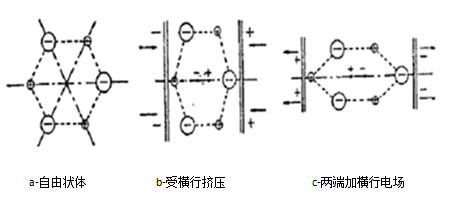改性PMnS-PZN-PZT陶瓷变温强场电学性质毕业论文
2021-03-12 00:00:16
摘 要
作为实现电能和机械能之间的相互转换的功能材料,压电陶瓷在现代社会的诸多领域都发挥着不可或缺的作用。改性PMnS-PZN-PZT是一类兼具高压电性和低损耗,适应于大功率应用的压电陶瓷。然而,目前对其高压电和低损耗的产生机理尚不清楚。此外,由于改性PMnS-PZN-PZT体系较新,目前尚缺少其在接近服役条件的变温强场下的性能数据,无法为相关器件的设计提供充分的依据,从而限制了其应用潜能。本文以改性PMnS-PZN-PZT为对象,使用电滞回线法对其变温强场电学性质进行研究。其研究具体内容如下:
1. 采用固相合成法制备改性PMnS-PZN-PZT陶瓷。XRD结果表明,改性PMnS-PZN-PZT陶瓷为钙钛矿结构,其物相组成为四方相结构含量占比67.89%,三方相结构含量占比32.11%;通过扫描电子透镜观察,其结构均匀致密,晶体为钙钛矿结构;样品具有较低的介电损耗tan δ = 0.0025,和较高的压电常数d33 = 348 pC/N。这一结果表明,改性PMnS-PZN-PZT适应于大功率应用。
2. 在弱场下(lt; 0.2 kV/mm),改性PMnS-PZN-PZT的极化和应变响应与外加电场成线性关系,没有明显的非线性和滞后效应,介电和压电损耗较小;当增大场强时,非线性和滞后效应逐渐变得明显,损耗增大。Rayleigh分析结果表明,畴壁运动导致了强场下产生明显的非线性和滞后;改性PMnS-PZN-PZT陶瓷中,由于缺陷的钉扎效应,使得部分畴壁运动变得可逆,这部分畴壁运动贡献了非线性,但几乎不产生损耗;非180°畴壁不可逆运动对介电损耗的贡献约为70.63%。
3. 高温下,由于缺陷被激活,畴壁退钉扎,畴壁的运动变得更加容易,因此强场非线性和滞后效应更为显著,出现明显非线性和滞后效应的阈值电场也逐渐降低。此外,高温下载流子激活,漏电流对损耗的贡献增加。
关键词:改性PMnS-PZN-PZT压电陶瓷;强场性质;压电性质;介电性质
Abstract
As a functional material for the conversion between electrical and mechanical energy, piezoelectric ceramics play an indispensable role in many areas of modern society. Modified PMnS-PZN-PZT is a kind of piezoelectric ceramics can withstand high voltage and maintain low loss, suitable for high power applications. However, the mechanism of its high voltage and low loss is not clear. In addition, due to the newer PMnS-PZN-PZT system, the performance data of the modified PMnS-PZN-PZT system are still lack of performance data near the service conditions, and can not provide sufficient basis for the design of the related devices, thus limiting their application potential. In this paper, modified PMnS-PZN-PZT as the object, the use of hysteresis loop method of its temperature field strength of the electrical properties of the study. The specific contents of the study are as follows:
1. Modified PMnS-PZN-PZT ceramics were prepared by solid phase synthesis. The XRD results show that the modified PMnS-PZN-PZT ceramics have a perovskite structure with a phase composition of 67.89% and a triad phase content of 32.11%. The structure of the PMnS-PZN-PZT Dense, the crystal is perovskite structure; the sample has a low dielectric loss tan δ = 0.0025, and a higher piezoelectric constant d33 = 348 pC/N. This result indicates that the modified PMnS-PZN-PZT is suitable for high power applications.
2. Under the weak field (lt; 0.2 kV / mm), the polarization and strain response of the modified PMnS-PZN-PZT are linearly related to the applied electric field, and there is no obvious nonlinearity and hysteresis effect. The dielectric and piezoelectric losses are Small; when increasing the field strength, the nonlinear and hysteresis effect gradually becomes obvious, the loss increases. Rayleigh analysis results show that the domain wall motion leads to significant nonlinearity and hysteresis in the strong field. In the modified PMnS-PZN-PZT ceramics, the partial wall motion becomes reversible due to the pinning effect of the defect. Wall motion contributes nonlinearity, but almost no loss occurs; non-180° domain wall irreversible motion contributes about 70.63% of dielectric loss.
3. High temperature, due to defects are activated, domain wall back pinning, domain wall movement becomes easier, so the strong field nonlinear and hysteresis effect is more significant, there are significant nonlinear and hysteresis effect of the threshold electric field is also gradually reduced. In addition, the high temperature carrier active, leakage current contribution to the loss increases.
Key Words: Modified PMnS-PZN-PZT piezoelectric ceramics; high-field properties, piezoelectric properties; dielectric properties
目 录
摘 要 I
Abstract II
目 录 III
第1章 绪论 1
1.1 压电效应与压电陶瓷材料 1
1.1.1 压电效应 1
1.1.2 压电材料 2
1.1.3 压电陶瓷的发展与应用 3
1.2 压电陶瓷的性能参数 4
1.2.1 压电常数 4
1.2.2 介电常数和介电损耗 4
1.2.3 机电耦合系数 4
1.2.4 机械品质因数 5
1.3 大功率压电陶瓷的研究 5
1.3.1 大功率应用对陶瓷性能的要求 5
1.3.2 大功率压电陶瓷的研究进展 5
1.3.3 PMnS-PZN-PZT四元系压电陶瓷 6
1.4 本论文课题的提出与研究内容 7
第2章 实验方法 8
2.1 样品制备 8
2.1.1 原料与设备 8
2.1.2 材料制备工艺 8
2.2 结构表征方法 10
2.2.1 表观密度测试 10
2.2.2 物相及晶体结构分析 10
2.2.3 显微结构分析 11
2.3 电学测量方法 11
2.3.1 压电性质 11
2.3.2 介电性质 12
2.3.3 极化响应与电滞回线 13
2.3.4 电致应变 13
2.4 强场电学性质分析方法 14
第3章 结果与讨论 15
3.1 改性PMnS-PZN-PZT表征 15
3.1.1 物相组成与显微结构 15
3.1.2 室温弱场电学性质 16
3.2 改性PMnS-PZN-PZT在强场非线性介电性质 16
3.2.1 强场极化响应的非线性 16
3.2.2 强场非极化介电行为及Rayleigh分析 17
3.3 改性PMnS-PZN-PZT在强场非线性压电性质 18
3.4 温度对改性PMnS-PZN-PZT在强场非线性介电性质的影响 20
第4章 结论 23
参考文献 24
致 谢 26
第1章 绪论
压电材料是一类能够实现电能与机械能之间相互转化的功能性材料,在现代社会诸多领域中都发挥着不可或缺的巨大作用。近年来,压电材料在各个领域的应用都开始普及,其中压电陶瓷应用最为广泛,而压电陶瓷大功率应用对其性能要求甚为严谨,因此我们对影响其性能的因素进行研究有着重要意义。
1.1 压电效应与压电陶瓷材料
1.1.1 压电效应
1880年,物理学家Curie兄弟[1]在研究热电征象和晶体对称性时,初次在α-石英晶体上发现了正压电效应。1881年,里普曼[2]依据热力学理论原理,依据能量守恒和电量守恒定律,从理论上提出了逆压电效应的存在。同年,Curie兄弟[1]以实验证明了石英晶体中存在逆压电效应。所谓“压电效应”,即是在机械应力(或外电场)作用下,某些各向异性的晶体成比例地产生电荷(或几何形变)的现象。根据作用机理不同,压电效应分为正压电效应和逆压电效应。当对压电陶瓷施加压力(拉力)时,压电陶瓷会产生收缩(伸长)变形,同时发生与应力成比例的介质极化,在晶体两端面将出现正负电荷,这种由“力”产生“电”的效应叫正压电效应;当对压电陶瓷施加与极化方向相同(相反)的电场时,则将产生与电场强度成比例的变形,极化强度增大(减小),压电陶瓷沿极化方向伸长(收缩),这种由“电场”产生“伸缩”的效应叫做逆压电效应,逆压电效应的晶体能够用于电声和超声工程的变送器等[3,4]。





